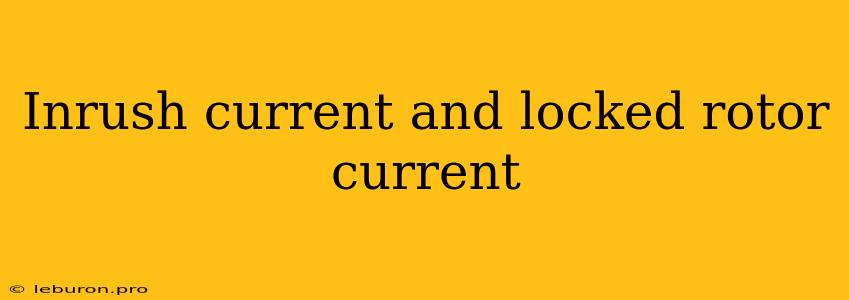Understanding Inrush Current and Locked Rotor Current in Electrical Systems
Electric motors are essential components in a wide range of applications, from industrial machinery to household appliances. When an electric motor starts, it draws a significant amount of current, known as inrush current. This high current surge is temporary and quickly decreases as the motor reaches its operating speed. However, another critical parameter related to motor starting is locked rotor current, which occurs when the motor shaft is prevented from rotating. Understanding the differences between these two currents is crucial for proper motor selection, protection, and system design.
Inrush Current: The Initial Surge
Inrush current refers to the high current drawn by a motor during the initial starting phase. This surge is primarily caused by the motor's inductance, which opposes the flow of current. When the motor is at rest, its inductance is high, leading to a significant impedance. As the motor starts to rotate, the inductance decreases, reducing the impedance and resulting in a drop in current.
Here's a breakdown of the factors contributing to inrush current:
- Motor Inductance: The motor's inductance acts like a temporary resistance, delaying the flow of current initially. As the motor accelerates, the inductance decreases, allowing more current to flow.
- Voltage: Higher supply voltage leads to higher inrush current.
- Motor Size and Type: Larger motors generally have higher inrush currents due to their increased inductance. Different motor types, such as induction motors and synchronous motors, also have varying inrush current characteristics.
- Load: While inrush current is primarily related to motor starting, the load connected to the motor can also influence the magnitude of the surge.
Locked Rotor Current: The Maximum Draw
Locked rotor current, also known as starting current, is the maximum current that a motor draws when its shaft is prevented from rotating. This condition can occur due to a mechanical blockage, a malfunctioning motor, or an overload. During a locked rotor condition, the motor's inductance remains high, resulting in a sustained high current draw.
Here's how locked rotor current differs from inrush current:
- Duration: Inrush current is a transient phenomenon that quickly decreases as the motor accelerates. Locked rotor current, on the other hand, persists as long as the motor remains locked.
- Magnitude: Locked rotor current is typically higher than inrush current due to the sustained high inductance.
- Consequences: Prolonged locked rotor conditions can lead to overheating, motor damage, and potentially tripping of circuit breakers or fuses.
Managing Inrush and Locked Rotor Currents
Understanding inrush current and locked rotor current is essential for safe and efficient operation of electric motors. Here are some strategies for managing these currents:
- Motor Selection: Choose motors with appropriate starting characteristics for your application. Consider using motors with low inrush current ratings or motors with built-in starting features like soft starts or variable frequency drives (VFDs).
- Protective Devices: Install proper overcurrent protection devices, such as circuit breakers or fuses, to prevent motor damage from excessive currents.
- Starting Techniques: Employ soft start techniques, such as VFDs, to gradually increase the motor's voltage and current during startup, reducing the initial inrush current.
- Load Management: Monitor the load on the motor and ensure that it doesn't exceed the motor's capacity. Overloading can lead to increased locked rotor current and potential motor damage.
Conclusion: Inrush Current and Locked Rotor Current Are Crucial Considerations
Inrush current and locked rotor current are critical parameters to consider when designing and operating electrical systems with electric motors. These currents can significantly impact motor performance, system efficiency, and safety. By understanding the factors that influence these currents and implementing proper mitigation strategies, you can ensure reliable and efficient operation of your motor-driven equipment. Always consult motor manufacturers' specifications and consult with qualified electrical engineers to ensure proper motor selection, protection, and system design.
